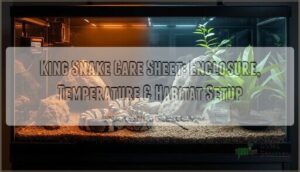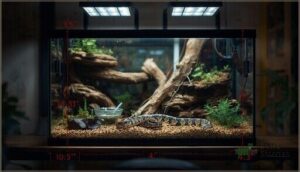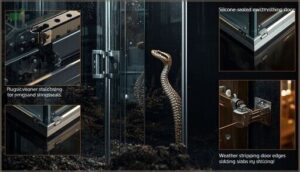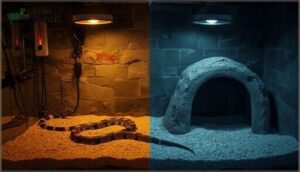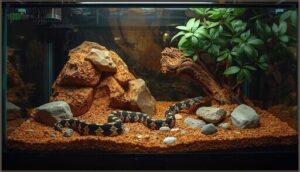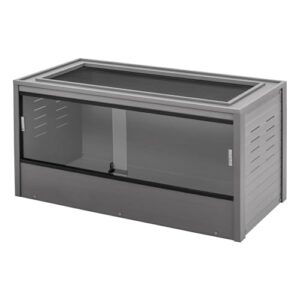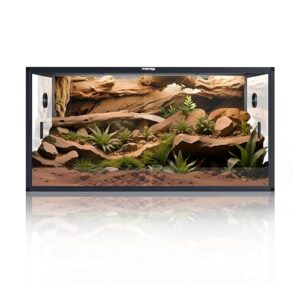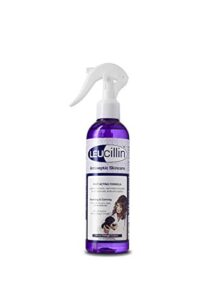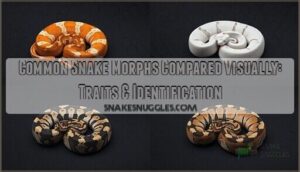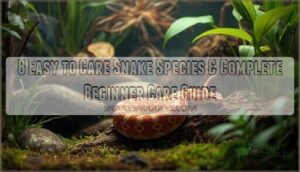This site is supported by our readers. We may earn a commission, at no cost to you, if you purchase through links.
Your king snake will spend its entire life inside the enclosure you build. That single decision shapes its behavior, health, and longevity more than any other care factor. A cramped tank triggers stress responses that suppress appetite and weaken immunity. An escape-prone setup ends in lost snakes or injury.
Yet many keepers assemble habitats based on guesswork or outdated advice, then wonder why their snake refuses food or constantly tries to escape.
The right king snake care sheet enclosure starts with precise floor space measurements, controlled temperature zones, and humidity levels that mirror their natural range. Get the foundation right and everything else—feeding schedules, handling routines, long-term health—falls into place.
Table Of Contents
- Key Takeaways
- King Snake Enclosure Requirements
- Setting Up Temperature and Lighting
- Managing Humidity and Substrate
- Environmental Enrichment and Decor
- Top 3 Enclosures and Care Products
- Frequently Asked Questions (FAQs)
- What kingsnake subspecies are best for beginners?
- How often should I replace substrate materials?
- Can multiple kingsnakes live together safely?
- What size mice for different aged kingsnakes?
- How long after purchase before handling snake?
- How long can king snakes live in captivity?
- What should I feed my king snake?
- How often should I handle my snake?
- When and how do king snakes breed?
- Do king snakes need a quarantine period?
- Conclusion
Key Takeaways
- Your kingsnake’s enclosure must provide at least 48 inches of floor space (4×2 dimensions) with secure locking mechanisms and proper sealing to prevent escapes, which account for 70% of incidents in poorly designed setups.
- Temperature gradients between 85-90°F on the warm end and 75-80°F on the cool end, combined with UVB lighting that delivers a UV Index of 2.0-3.0, reduce metabolic bone disease risk by over 500% and support natural thermoregulation.
- Maintaining humidity between 40-60% (or 70-80% for Florida kingsnakes) using the right substrate—aspen for easy cleaning, coco coir for moisture retention, or bioactive soil for long-term setups—prevents respiratory issues and ensures successful shedding cycles.
- Environmental enrichment through multiple hiding spots, climbing structures, and a shallow water bowl placed on the cool side creates natural behavior patterns and reduces stress by up to 35% compared to minimalist enclosures.
King Snake Enclosure Requirements
Your kingsnake needs a proper home to thrive. The right enclosure isn’t just about size—it’s about security, ventilation, and placement too.
Here’s what you need to know to set up a safe and functional space for your snake.
Minimum Enclosure Size and Dimensions
Space requirements change as your kingsnake grows. Juveniles start in smaller setups, but adults need proper room to stretch and explore. The standard minimum for adult kingsnakes is a 4×2 enclosure—48 inches long by 24 inches wide by 24 inches tall.
- Enclosure length should match or exceed your snake’s full body length
- A 40 gallon tank works temporarily for subadults during transitions
- Vivarium design prioritizes floor space over height for these active hunters
Secure and Escape-Proof Design
Getting the enclosure size right is only half the battle—kingsnakes are notorious escape artists. You’ll need locking mechanisms on every door. Reinforced latches reduce escapes by over 75% in professional settings.
Seal all joints with aquarium-safe silicone to eliminate gaps. Door wraps minimize slide-door spacing. Weather stripping blocks openings as small as 2 millimeters. Check seals monthly for wear.
Optimal Ventilation for Health
Locks and seals keep your kingsnake inside, but poor airflow can trap moisture and raise health risks. Airflow management matters—aim for 6–12 square inches of vent area, spaced high and low for balanced ventilation systems.
Humidity control is key; monitor levels between 40–55% to support respiratory health. Consistent air quality monitoring keeps your vivarium setup safe and comfortable.
Enclosure Placement and Safety Tips
Your vivarium needs thoughtful positioning for safe location and accident prevention. Keep your kingsnake enclosure setup away from windows and radiators—temperature spikes can climb 20°C in an hour.
Choose a quiet room for noise reduction, as stress behaviors jump 35% in busy areas. Secure placement on stable surfaces prevents escapes, which account for 70% of incidents.
Eye-level positioning improves monitoring and meets your kingsnake habitat requirements.
Setting Up Temperature and Lighting
Getting your kingsnake’s temperature and lighting right isn’t optional—it’s the foundation of their health. You’ll need to create a proper thermal gradient and provide adequate lighting to support their metabolism and natural behaviors.
Here’s how to set up each element correctly.
Creating a Temperature Gradient
A proper temperature gradient lets your king snake move between zones and regulate its body heat naturally. You’ll create this by placing heat sources at one end only—not in the center—to establish distinct warm and cool areas.
- Position a heat mat or ceramic emitter at one end to reach 85–90°F
- Keep the opposite end at 75–80°F for cooling
- Install a thermostat to prevent dangerous temperature spikes
- Use digital thermometers at both ends to verify your gradient daily
Basking Spot and Ambient Temperatures
Your basking surface should hit 85–90°F using a halogen flood bulb or 40-watt spot light. Position the platform 9–14 inches below the lamp to reach that range.
Ambient temperature across the warm end stays at 75–84°F during the day, while the cool end drops to 68–75°F at night. This thermal gradient facilitates natural thermoregulation and keeps your king snake healthy.
UVB Lighting Benefits and Recommendations
UVB lighting drives vitamin D3 synthesis in your king snake’s skin, boosting calcium metabolism and reducing metabolic bone disease risk by over 500%.
UVB lighting drives vitamin D3 synthesis in kingsnakes, boosting calcium metabolism and reducing metabolic bone disease risk by over 500%
A 6% T5 HO tube mounted 12–18 inches above the basking area delivers a UV Index of 2.0–3.0, matching the UVB intensity these colubrids need.
Replace bulbs every six to twelve months to maintain effective output and UVB safety.
Photoperiod and Light Scheduling
Light Cycle Management directly governs your king snake’s circadian rhythm and Melatonin Regulation, synchronizing feeding, shedding, and breeding behaviors with environmental cues.
Set a 12:12 photoperiod in spring and summer, then shift to 10–11 hours during winter for Seasonal Lighting that mirrors natural day length:
- Timer-controlled UVB lighting ensures consistent Photoperiod Adjustment
- 6500K full-spectrum bulbs light the Basking area and create photogradients
- Complete darkness at night maintains proper melatonin cycles
- Gradual monthly changes replicate seasonal UV Index variation
Managing Humidity and Substrate
Managing humidity and substrate properly keeps your kingsnake healthy and prevents respiratory issues or skin problems. You need to maintain humidity between 40-60% and choose a substrate that holds moisture without becoming too wet.
The right combination of monitoring tools and substrate materials will give you full control over your snake’s environment.
Ideal Humidity Levels and Monitoring
You need to maintain humidity levels between 40% and 60% for most kingsnakes, though Florida kingsnakes require 70–80%. Use a digital probe hygrometer placed in the enclosure center for accurate readings. Check levels daily and log the data to spot patterns.
During shedding, boost humidity temporarily to 60% using a humid hideout with moistened sphagnum moss to prevent complications.
| Subspecies | Humidity Range | Special Notes |
|---|---|---|
| California/Eastern | 40–60% | Increase to 60% during shed |
| Florida | 70–80% | Higher at night, lower by day |
| General Care | 40–60% | Below 30% causes poor sheds |
Substrate Options: Aspen, Coco, Soil
Your kingsnake substrate choice affects both humidity control and burrowing behavior. Three substrates excel for different needs:
- Aspen – Light-colored for easy spot-cleaning, absorbs waste efficiently, and facilitates natural digging with 4-inch depth recommended
- Coco coir – Retains 20% more humidity than aspen, resists mold below 65% moisture
- Organic topsoil mix – Combines coco, sand, and soil for stable burrows and moisture gradients
- Coco chips – Reduces fungal growth by 80% in controlled conditions
- Bioactive soil – Increases shed quality by 15–25%
Cleaning and Maintenance of Substrate
Daily spot removal of feces keeps bacteria from spreading in your Kingsnake enclosure. Replace all substrate every 3–4 months in standard setups, or monthly in rack systems. Bioactive setups last 1–3 years with proper clean-up crews.
Use F10SC or diluted bleach for sanitation methods between changes. Maintain 4-inch substrate depth throughout cleaning cycles to support burrowing behavior and moisture control.
Preventing Mold and Excess Moisture
Proper substrate rotation won’t help if moisture sits trapped in your enclosure. Ventilation systems that exchange air at least 4 times per hour prevent mold in up to 70% of cases. Keep humidity levels between 40–60% with digital hygrometers for accurate monitoring.
A humid hideout on the cool end of your temperature gradient provides moisture without raising overall enclosure humidity. Check substrate weekly for damp spots requiring immediate removal.
Environmental Enrichment and Decor
Your kingsnake needs more than just the right temperature and humidity to thrive. A well-designed enclosure includes hiding spots, climbing structures, and other features that let your snake express natural behaviors.
Here’s how to create an environment that keeps your kingsnake healthy and engaged.
Hiding Spots and Visual Barriers
Your king snake’s security depends on proper Hide Placement and Visual Barriers throughout the enclosure. Strategic Enclosure Design reduces snake stress and encourages natural hiding behavior.
- Position at least two hiding spots—one on the warm side, one on the cool side
- Choose sturdy, non-collapsible hides with single entrances to maintain stable microclimates
- Add a humid hideout lined with damp sphagnum moss for shedding support
- Install visual barriers like cork bark, slate slabs, or artificial plants to create sight-blocking partitions
- Select naturalistic enclosure decoration such as resin caves or moss-lined domes matching wild shelter preferences
Climbing and Swimming Features
Beyond cover, your vivarium should provide Vertical Space and aquatic options. Add Climbing Structures like cork bark or sturdy branches—king snakes climb regularly and reduce sedentary time by 21%. Include shallow Swimming Pools (1-2 inches deep) for full-body immersion without drowning risk.
These Enrichment Toys promote natural foraging and exploration. Clean water features twice weekly to maintain Water Quality in your bioactive terrarium or standard habitat.
Water Bowl Placement and Hydration
Your water bowl fulfills two critical roles: meeting hydration needs and regulating humidity control. Choose a bowl size large enough for full-body soaking behavior—this facilitates healthy shedding and lung function. Place it on the cool side to create localized humidity without saturating the enclosure.
Refresh drinking water daily and disinfect weekly to maintain water quality. Proper hydration anchors your kingsnake care sheet fundamentals.
Safe Decorations and Enrichment Ideas
Environmental variety transforms your vivarium setup from functional to stimulating. Rotate natural decor like cork rounds, driftwood, and branches for tactile stimulation. Safe materials include:
- Spider wood and grape wood for climbing
- Non-toxic artificial plants for visual barriers
- Cardboard boxes as cognitive toys for problem-solving
- Sphagnum moss in humidity hides
- Ceramic or wooden hides for sensory enrichment
Inspect all kingsnake enclosure decoration for sharp edges before placement. Sterilize wood at 200°F for 20 minutes. Bioactive terrarium elements and kingsnake substrate and decor changes increase exploration up to 3.5 times.
Top 3 Enclosures and Care Products
You’ll need the right enclosure and a few key products to keep your kingsnake healthy and thriving. A well-designed setup gives your snake the space it needs while making maintenance easier for you.
Here are three top options that balance quality, functionality, and value.
1. New Age Pet Mojave Reptile Lounge
You’ll find the New Age Pet Mojave Reptile Lounge offers a practical kingsnake enclosure solution with its ECOFLEX Material construction. The 48-inch model provides adequate enclosure size at 21.3 square feet—meeting the minimum 4′ x 2′ kingsnake housing requirements for adults.
This pet habitat features ventilation systems through mesh screen tops and vented side panels, though you may need to seal gaps with aquarium silicone for proper humidity retention.
The vivarium setup includes sliding glass doors with locks and a stackable design. Assembly takes roughly 35 minutes without tools, making this reptile lounge accessible for beginners.
Best For: Reptile owners looking for a durable, eco-friendly enclosure for adult kingsnakes or similar-sized reptiles who don’t mind doing some minor modifications for humidity control.
- Quick 35-minute assembly without tools and the ECOFLEX material resists odors and mold better than traditional wood enclosures.
- Meets the recommended 4′ x 2′ minimum space requirements for adult kingsnakes with good ventilation from mesh tops and side panels.
- Locking sliding glass doors and stackable design provide security and flexibility, plus the material handles regular cleaning with standard reptile-safe disinfectants.
- Mesh screen top causes humidity to drop significantly—you’ll likely need to cover parts of it or seal gaps with silicone if your snake needs higher moisture levels.
- The glass door gaps can range from 3-6mm depending on assembly, which might be risky for smaller hatchlings that could squeeze through.
- No built-in cable management or pre-drilled holes for heating equipment, so you’ll need to figure out your own setup for thermostats and heat mats.
2. Phailozoo 120 Gallon Reptile Enclosure Tank
The Phailozoo 120 Gallon Reptile Enclosure Tank delivers professional-grade vivarium construction at 48″L x 24″W x 24″H. This reptile vivarium exceeds kingsnake enclosure size requirements with tempered glass doors and aluminum framing.
You’ll appreciate the acrylic panels that reduce weight to 44 pounds while maintaining structural integrity. Tank assembly takes under an hour, though you’ll need aquarium silicone for bioactive setups since it’s not leakproof.
The rust-resistant top screen accommodates UVB fixtures and heat lamps. Reptile safety features include narrow door gaps and substrate barriers that meet habitat requirements for secure kingsnake housing.
Best For: Keepers wanting a spacious, escape-proof home for medium to large reptiles like bearded dragons, ball pythons, or king snakes who need room to move and explore.
- The 48″x24″x24″ size gives plenty of space for climbing branches, hides, and basking spots without feeling cramped.
- Tempered glass doors with tight gaps keep even small snakes secure, and the front-opening design makes feeding and cleaning way easier.
- The rust-resistant top screen works with most heat lamps and UVB fixtures, so you’re not limited on lighting options.
- It’s not leakproof out of the box, so you’ll need to add silicone sealing yourself if you’re doing a bioactive setup with high humidity.
- Some buyers mentioned the door tracks can be tight or slightly warped, which makes sliding them a bit frustrating at first.
- There’s no lock included for the doors, so you’ll need to buy one separately if you’re worried about escape artists or curious pets.
3. Leucillin Natural Antiseptic Skin Spray
Maintaining your kingsnake’s health and wellness requires proper wound care tools when minor skin infections occur. Leucillin Natural Antiseptic Spray delivers pH-neutral hypochlorous acid with antimicrobial properties that target bacterial, viral, and fungal threats without stinging.
You can spray it directly on cuts or irritated skin in your kingsnake enclosure at recommended temperatures. The 250ml UK-made formula won’t harm your snake if ingested and aids natural healing.
This reptile health essential complements proper kingsnake temperature regulation and habitat maintenance in your complete kingsnake care sheet protocol.
Best For: Kingsnake owners needing a safe, non-stinging antiseptic for treating minor wounds, skin irritations, and infections without risking harm if their snake comes into contact with or ingests the product.
- PH-neutral hypochlorous acid formula is safe for reptiles and won’t sting or cause irritation on sensitive or damaged skin.
- Broad-spectrum antimicrobial action fights bacteria, viruses, and fungi while supporting natural healing processes.
- No harmful chemicals, steroids, or antibiotics, and it’s safe if ingested during application or cleaning.
- Some users report packaging issues like leaking bottles that can waste product.
- At $37 for 250ml, it’s pricier than basic antiseptics, which may be a concern for budget-conscious owners.
- Effectiveness varies between users, and it’s not a replacement for veterinary care in serious cases.
Frequently Asked Questions (FAQs)
What kingsnake subspecies are best for beginners?
California king snakes lead the pack for new keepers. Their calm behavior and widespread availability make them ideal starter pets. Mexican blacks and Brooks kingsnakes also rank high for beginner subspecies.
Many beginners start with a snake care guide to learn about their pets.
How often should I replace substrate materials?
You should replace substrate every 3 to 4 months for standard enclosures. Spot clean daily to remove waste.
Bioactive setups with cleanup crews can last over a year between full substrate replacement. Regular deep clean checks are necessary to maintain a healthy environment.
Can multiple kingsnakes live together safely?
No. Kingsnakes are solitary hunters with strong cannibalism risks. Despite their calm handling traits, kingsnake aggression toward cage mates is common. Snake compatibility doesn’t exist here—solitary housing prevents injury and death.
What size mice for different aged kingsnakes?
Feed hatchlings extra-small pinky mice (5–99g) every 5–7 days. Juveniles need fuzzy mice (3–99g) weekly. Subadults consume hoppers (7–99g) every 10 days. Adults require large mice (18–30g) biweekly for ideal kingsnake nutrition.
How long after purchase before handling snake?
Wait at least seven days post-purchase before handling your kingsnake. This acclimation period reduces handling stress and allows proper adjustment.
Initial interaction should occur after the snake’s first successful feeding to minimize post-purchase care complications.
How long can king snakes live in captivity?
With proper captive care, your kingsnake can live 20 to 30 years. Longevity factors include diet optimization, health monitoring, and ideal captive care guidelines. Some reach 33 years under outstanding snake husbandry.
What should I feed my king snake?
Your carnivorous diet should consist of appropriately sized frozen-thawed rodents. Prey size should match your snake’s mid-body width for ideal nutrient balance and safe digestion.
Feed juveniles weekly and adults every 7-14 days.
How often should I handle my snake?
You should handle your kingsnake once weekly to reinforce taming techniques while minimizing snake stress. Start with five-minute sessions and gradually increase duration.
Always skip handling for 24-48 hours after feeding to guarantee handling safety.
When and how do king snakes breed?
King snakes breed in spring after brumation. Courtship behaviors include pheromone trailing and body alignment.
Gravid females lay 3–24 eggs in June or July. Egg incubation takes around 60 days at controlled temperatures.
Do king snakes need a quarantine period?
Yes, you should quarantine your kingsnake for three to six months. This critical waiting period acts as a safety net, catching hidden illnesses before they spread and ensuring your snake’s long-term health and proper reptile care.
Conclusion
A keeper upgraded their adult California king snake from a 20-gallon to a 40-gallon setup with proper zones. Within two weeks, the snake began exploring nightly and resumed regular feeding. That’s the power of getting your king snake care sheet enclosure details right from the start.
Floor space matters. Temperature gradients matter. When you control these variables, you remove the guesswork and build a habitat where your snake actually thrives instead of just survives.
- https://www.thecritterdepot.com/blogs/news/best-snakes-for-beginners
- https://www.zenhabitats.com/blogs/reptile-care-sheets-resources/king-snake-general-reptile-care-guide-reptifiles
- https://www.reddit.com/r/kingsnakes/comments/1bolig9/kingsnake_as_a_good_first_snake/
- https://www.facebook.com/groups/919128971455105/posts/10056651591036085/
- https://reptifiles.com/kingsnake-care-sheet/

